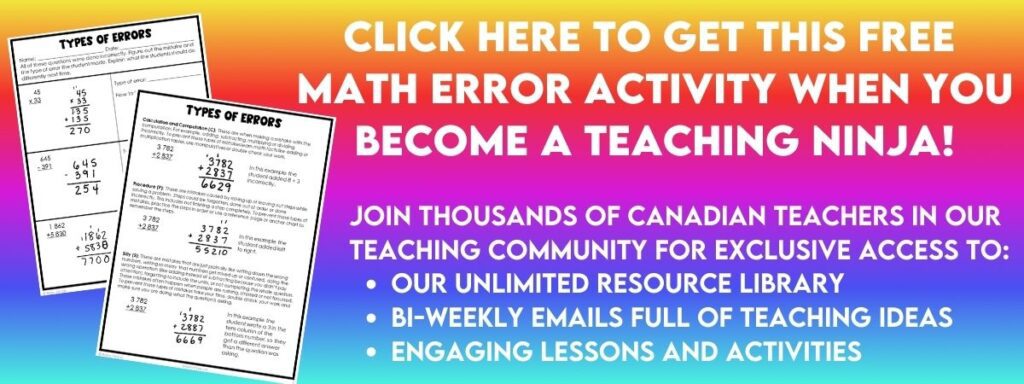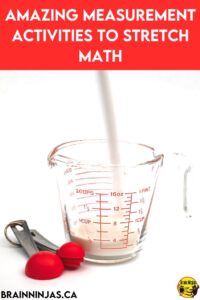
Measurement is one of those math strands that requires lots of hands-on activities and practice. While students can learn about the different measurements and units through learning about them, it essentially takes a lot of practice measuring to really understand how all the measurements work together.
We have found that a combination of book learning and reference materials supports students while they use units to measure different items. Read on to learn about some of the different measurement activities we use to help students master the metric system (and other units of measurement).
Tools to Use With Your Measurement Activities
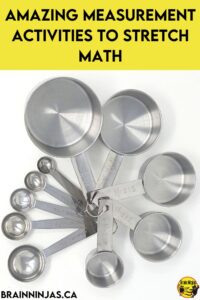
There are lots of different things you can use for measurement in your classroom.
Length, Height and Width
Collect rulers, sewing measuring tapes, measuring tapes, metre sticks, or yardsticks.
Ikea has great paper measuring tapes; just call a store and ask a manager if you can have a handful. If you laminate them, they last forever and are really easy to store. Having paper measuring tapes, or the ones tailors use, makes measuring circumference or curved surfaces so much easier for students this age (because they don’t use formulas yet).
Weight and Mass
Use scales (food scales are great for the classroom) or a fishing scale. It is difficult to teach the difference between weight and mass for younger students, but the measurements are the same using scales for this age.
Graph paper is one of the best tools to use for area and perimeter. One of our favourite places to get free graph paper is on this site.
Volume and Capacity
Use measuring cups, measuring spoons, containers with different capacity amounts, and containers that can be used to measure the volume. While the volume of rectangular prisms can be done by measuring length, width, and height, the volume of less structured objects is easier using objects to fill a container.
Non-standard units include centimetre cubes, which are great for measuring volume before students use formulas.
Resources to Teach and Assess Measurement
We have created resources that are useful for explicitly teaching measurement concepts in our classroom.
Interactive Notebooks
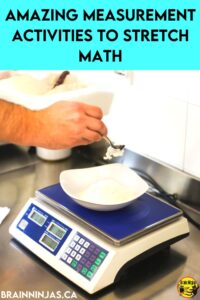
We use interactive notebooks during math class. Students create a reference page with all the information and then use it while they practice in more hands-on ways. To learn more about interactive notebooks, read our post How to Change Math With Interactive Notebooks.
Time and Measurement Interactive Unit for Grade 3 can be found on TpT ($USD) or our BN Shop ($CAN). It includes metric and customary measurements and everything you need to teach time concepts, length, mass, capacity, right angles, and perimeter.
Our Measurement Interactive Unit for Grade 4 can be found on TpT ($USD) or our BN Shop ($CAN). It includes measuring length, area, perimeter, volume, capacity, and types of angles with metric units.
The Measurement Interactive Math Unit for Grade 4/5 can be found on TpT ($USD) or our BN Shop ($CAN). It includes measuring length, area, perimeter, volume, capacity, and types of angles with metric units.
Measurement Interactive Unit for Grade 5 can be found on TpT ($USD) or our BN Shop ($CAN). It includes measuring length, area, perimeter, volume, and capacity with metric units.
Our Measurement Interactive Math Unit for Grade 5/6 can be found on TpT ($USD) or our BN Shop ($CAN). It includes metric referents, metric conversions, measuring length, volume, capacity, and types of angles with metric units.
The Measurement Interactive Math Unit for Grade 6 can be found on TpT ($USD) or our BN Shop ($CAN). It includes metric referents, metric conversions, measuring length, volume, capacity, and types of angles with metric units.
Task Cards
Task cards are great because you can single out questions, easily differentiate and even get students up and moving. You can learn more about how we leverage task cards in our classroom in our post, The Trouble With Task Cards and How to Fix It.
We have lots of different task card sets.
Area and Perimeter
- Area Task Cards are available on TpT ($USD) or our BN Shop ($CAN).
- Area and Perimeter Task Cards are available on TpT ($USD) or our BN Shop ($CAN).
- Perimeter Task Cards are available on TpT ($USD) or our BN Shop ($CAN).
Volume
- Volume of Rectangular Prisms Task Cards are available on TpT ($USD) or our BN Shop ($CAN).
Capacity
- Capacity (mL and L) Task Cards are available on TpT ($USD) or our BN Shop ($CAN).
Angles
- Measuring Angles Task Cards are available on TpT ($USD) or our BN Shop ($CAN).
Worksheets
We don’t use worksheets daily, but they can serve a purpose. Sometimes, students need a little extra practice, or they make a great quick assessment. We put together a list of activities we use with worksheets in this post: Math Worksheet Games Your Students Will Love.
Length and Mass
- Length (mm, cm, m) Worksheets are available on TpT ($USD) or our BN Shop ($CAN).
- Mass Worksheets are available on TpT ($USD) or our BN Shop ($CAN).
- Length (inches, feet, yards) Worksheets are available on TpT ($USD) or our BN Shop ($CAN).
- Length (mm, cm, m) (advanced) Worksheets are available on TpT ($USD) or our BN Shop ($CAN).
Capacity
- Capacity (mL, L) (simple) Worksheets are available on TpT ($USD) or our BN Shop ($CAN).
- Capacity (mL and L) (advanced) Worksheets are available on TpT ($USD) or our BN Shop ($CAN).
Volume
- Volume of Rectangular Prisms Worksheets are available on TpT ($USD) or our BN Shop ($CAN).
- Calculating Volume | Comparing Area and Perimeter Worksheets are available on TpT ($USD) or our BN Shop ($CAN).
Area and Perimeter
- Perimeter Worksheets are available on TpT ($USD) or our BN Shop ($CAN).
- Area of 2D Shapes Worksheets are available on TpT ($USD) or our BN Shop ($CAN).
- Area of Rectangles Worksheets are available on TpT ($USD) or our BN Shop ($CAN).
- Perimeter of Rectangles Worksheets are available on TpT ($USD) or our BN Shop ($CAN).
- Perimeter with Geoboards Worksheets are available on TpT ($USD) or our BN Shop ($CAN).
- Area Using Tiling and Grids Worksheets are available on TpT ($USD) or our BN Shop ($CAN).
- Comparing Area and Perimeter of Regular and Irregular Polygons Worksheets are available on TpT ($USD) or our BN Shop ($CAN).
- Area of Triangles Worksheets are available on TpT ($USD) or our BN Shop ($CAN).
- Area of Parallelograms Worksheets are available on TpT ($USD) or our BN Shop ($CAN).
- Area of Trapezoids Worksheets are available on TpT ($USD) or our BN Shop ($CAN).
- Perimeter of Complex Polygons Worksheets are available on TpT ($USD) or our BN Shop ($CAN).
- Area of Rectangles Using a Formula Worksheets are available on TpT ($USD) or our BN Shop ($CAN).
Angles
- Right Angles Worksheets (simple) are available on TpT ($USD) or our BN Shop ($CAN).
- Types of Angles Worksheets are available on TpT ($USD) or our BN Shop ($CAN).
- Types of Angles Worksheets (all types) are available on TpT ($USD) or our BN Shop ($CAN).
- Interior Angles Worksheets | Triangles and Quadrilaterals are available on TpT ($USD) or our BN Shop ($CAN).
Conversions & Referents
- Metric Conversions Worksheets are available on TpT ($USD) or our BN Shop ($CAN).
- Metric Referents Worksheets are available on TpT ($USD) or our BN Shop ($CAN).
Try Error Analysis
One activity we love to do is complete a measurement worksheet with answers that are a mix of correct and incorrect. Then, we hand it to students and ask them to check the answers. You can use this Error Analysis Activity with any worksheet. We’ll send it directly to your inbox when you sign up for our email list. If you’re already on the list, you can find it in our Resource Library.
Measurement Activities for the Classroom
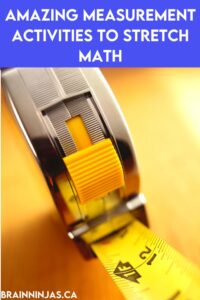
Measuring Objects
Have kids measure objects around the classroom using a ruler, tape measure, or metre stick. Ask them to record the length, width, and height of the objects and compare their measurements with those of their peers.
If your students aren’t ready for standard units, try using non-standard units like their own feet, an eraser, or a book. Students can see how many books wide their desks are or how many of their own feet the length of the classroom is.
Once students understand non-standard units, they can find referents. Referents are items that can be used in place of standard units because they are close to the accurate measurement. For example, if students learn that the width of a finger is about 1 centimetre, they can use their fingers to measure the length of their pencil.
Estimation
Have kids estimate the length, weight, or volume of objects and then measure them to see how close their estimates were to the actual measurements. This is more effective once students understand referents.
Cooking and Baking
While cooking and baking usually take place at home, there are some recipes that can be done at school. Best of all, students can take what they have learned home with them and apply it to their daily lives. Involve kids in cooking and baking activities that require them to measure ingredients such as flour, sugar, or milk. Ask them to measure using measuring cups and spoons and record the amounts in recipes.
Building and Construction
Provide kids with blocks or other construction materials and have them build structures of different sizes. Ask them to measure the length, width, and height of their structures and compare them with those of their peers.
Gardening
Have kids measure the height and growth of plants over time using a ruler or measuring tape. This can help them understand how plants grow and how to track their progress. This can be part of your science curriculum, or you can grow plants around the school as part of your community. You can read our blog post about how we use plants in the classroom here: How to Grow a Healthy Classroom with Plants.
Science Experiments
Provide kids with materials for science experiments that require measurement, such as measuring the pH of water or measuring the mass of objects using a balance. When participating in science experiments, have students do as much measuring as possible during the procedure and their observations.
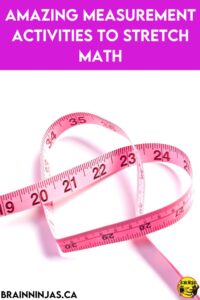
Books to Accompany Your Measurement Activities
If you are looking to add some books to your math class, check these out.
Me and the Metric System by Loreen Leedy
How Long or How Wide?: A Measuring Guide by Brian Cleary
Math for Kids: Metric System by Angela Royston
The Metric System Made Simple by Albert James
Metric Madness: Over 150 Wacky Ways to Measure by John Marciano
Are You Teaching Math All Year?
Isn’t teaching time a form of measurement? Yes, we actually dedicated a whole post to time activities.
You might find these other math posts helpful.
- How to Use Interactive Notebooks to Teach Number Sense
- Mastering the Angles: Innovative Approaches to Teaching Geometry Concepts
- How to Teach Students to Analyze Errors in Math
- How to Help Your Students Master Decimal Operations
- Ways to Bring Graphing Activities into Your Classroom Daily
- How to Add Candy to Your Math Lessons
- How to Teach Successful Long Division Strategies
- Conquer Math With These Proven Multiplication Strategies
- How to Differentiate Your Math Lessons
- How to Make Teaching Patterns Painless
- How to Demystify Math With These 7 Algebra Activities
- 7 Ways to Upgrade Your Fraction Strategies
- Ways to Teach Classifying Triangles
- How to Teach Rounding Numbers
What are some of the measurement activities you love to use in your classroom? Let us know all about them in the comments below.

